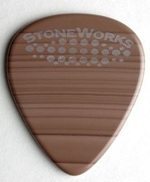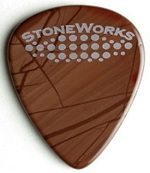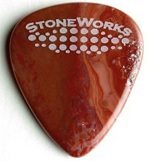Get Your Tone from Stone! StoneWorks Guitar Picks.
Marc Johnson | Mar 11, 2011 | Comments 4
How Stone Learned to Rock: TTK talks with Mike Stone of StoneWorks Picks.
Marc Johnson for TheToneKing.com
 One thing that Mike Stone said that really made sense to me was, “it’s another tool to get another tone.” It was a smart response to a fundamental question that had been floating around my head since The Tone King told me that I would be talking to the founder of StoneWorks Picks.
One thing that Mike Stone said that really made sense to me was, “it’s another tool to get another tone.” It was a smart response to a fundamental question that had been floating around my head since The Tone King told me that I would be talking to the founder of StoneWorks Picks.
“So, why stone picks?”
When Mike responded to my skepticism, it immediately reminded me of when I was a kid just learning how to play guitar. Sometimes, just for the hell of it, I would use quarters or pieces of cardboard or Popsicle sticks to pluck my strings and would be intrigued with how the tone would change every time I moved to a different material. Stone picks? Yeah, they’re kind of like that.
Maybe it’s because of his name (yeah, it’s his real name) but Mike Stone has always been into rocks. Since he didn’t have much money lying around, Mike would entertain himself and his kids walking down to the creek to find fossils and geodes. Although Mike had been playing guitar for more than 30 years, he never paired his passions for stones and his axe until his buddy Rusty Logan asked him to do him a favor.
 You see; Rusty lost his fingertip in a farming accident, which made it hard for him to hold a guitar pick. So, Rusty told Mike, “you gotta make me an agate pick.” From there, it clicked, and Mike has turned his hobby of shaping stones into a full time business.
You see; Rusty lost his fingertip in a farming accident, which made it hard for him to hold a guitar pick. So, Rusty told Mike, “you gotta make me an agate pick.” From there, it clicked, and Mike has turned his hobby of shaping stones into a full time business.
Within a year, Mike has already expanded his business to include 20 dealers as well as selling his picks directly through his website. Winning “Best in Show” at 2010 NAMM in Nashville, StoneWorks picks are definitely turning a few heads. Family owned and operated, Mike and his kids still travel all over the United States, looking for precious stones, saving their spoils to be cut, shaved, and beveled to anywhere between 1.43 and 4.45 mm.
 The thicknesses can be intimidating. Personally, I use 1.26mm Claytons. So, I held three of them together to get an inkling of how thick the stone picks could get, but Mike contends that I’m not thinking about it the right way.
The thicknesses can be intimidating. Personally, I use 1.26mm Claytons. So, I held three of them together to get an inkling of how thick the stone picks could get, but Mike contends that I’m not thinking about it the right way.
Mike measures his picks at the center, but they are beveled at the ends so that the part that makes contact with the string is much thinner. Also, Mike says that because they are polished, StoneWorks picks have a “frictionless play,” gliding off of the strings rather than dragging through them. All of which makes StoneWorks picks feel lighter than plastic picks that can feel bulky and cumbersome when they reach those higher gauges. In short, don’t let the measurements fool you; a 1.5mm stone pick is not going to feel the same as a 1.5mm chunk of celluloid.
 If you check out StoneWorks picks on YouTube, you’ll get a pretty good idea of the tonal differences between celluloid picks and stone. On acoustic guitar, the differences are most noticeable; the guitar sounds brighter with a stronger ‘click’ on the attack, giving the guitar a stronger mid to high projection with stone than with plastic.
If you check out StoneWorks picks on YouTube, you’ll get a pretty good idea of the tonal differences between celluloid picks and stone. On acoustic guitar, the differences are most noticeable; the guitar sounds brighter with a stronger ‘click’ on the attack, giving the guitar a stronger mid to high projection with stone than with plastic.
Knowing the guys and gals who tune into the TTK community, I really wanted to find out what these picks would do for those who were about to rock. What I noticed is that the ‘click’ that I mentioned earlier really hits hard when the stone pick is used on an amped-up guitar cranked on overdrive. I also noticed something interesting when I heard someone shredding with a StoneWorks pick. The added ‘click’ seemingly compensated for a weaker attack that is usually the result of playing really fast, giving the illusion that the player was hitting the strings much harder than he really was. Harmonics come through differently as well. You can definitely pinch with a stone pick, but the harmonic articulation is going to differ than when you attack your string with plastic.
 Although we always hear about the half-life of plastic being horrifyingly close to SE-82, that half-life doesn’t mean a damn when you’re giving them the cheese-grater treatment over a series of sweeping sixteenth notes. A stone pick will likely be around long after you, your kid, your kid’s kid, etc… have all hung up their axes. Montana Moss-Agate, Mike’s favorite, has been around for 10 million years, and, I don’t care how heavy you play, there’s no string that’s going to wear that down. Mike considers every pick a piece of art, and, I have to say, they are damn pretty.
Although we always hear about the half-life of plastic being horrifyingly close to SE-82, that half-life doesn’t mean a damn when you’re giving them the cheese-grater treatment over a series of sweeping sixteenth notes. A stone pick will likely be around long after you, your kid, your kid’s kid, etc… have all hung up their axes. Montana Moss-Agate, Mike’s favorite, has been around for 10 million years, and, I don’t care how heavy you play, there’s no string that’s going to wear that down. Mike considers every pick a piece of art, and, I have to say, they are damn pretty.
From talking with Mike, I think he would agree; stone picks are not necessarily better than celluloid, Tortex, acetal, ultem, lexan, acrylic, or…well, you get the point. They’re just different. Slide players bark all the time about metal vs. glass, and people are probably going to have the same arguments about Stone vs. Tortex. But, at TheToneKing.com, we are always about bringing you the word on the newest gear, and StoneWorks picks are definitely making people talk. Besides, with a name like Stone, you know that this guy should know how to rock.
Become a Fan of StoneWorks on Facebook. Visit StoneWorksPicks.com.
Tiny URL for this post:
Filed Under: Featured • Reviews • Accessories
About the Author: Marc published his first novel Becoming in 2010. It’s a kick-ass book with monsters and dreams and stuff, and you should buy it. Since then, he’s written thousands of articles for TheToneKing.com, many of which have been picked up for circulation by manufacturers and other news outlets.
His next book, Drugs and Pancakes, should be available early 2014 if his alcoholic editor can find time to work on it in-between destroying his liver and screaming about punctuation. He graduated from Roosevelt University with honors, which means that he’s not as dumb as he looks.
He’s been playing guitar for over 25 years, which is almost twice as long as most of his students have been alive.




















